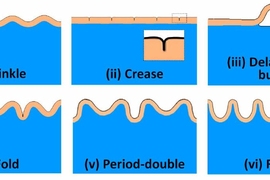The process of wrinkle formation is familiar to anyone who has ever sat in a bathtub a little too long. But exactly why layered materials sometimes form one kind of wrinkly pattern or another — or even other variations, such as creases, folds, or delaminated buckles — has now been explained at a fundamental level by researchers at MIT.
The underlying process is the same in all of these cases: Layers of material with slightly different properties — whether skin tissue or multilayer materials created in the lab — tend to form patterned surfaces when they shrink or stretch in ways that affect the layers differently. But the new analysis, for the first time, creates a unified model that shows exactly how the properties of the individual layers, and how they are bonded to each other, determines the exact form of the resulting texture.
MIT associate professor of mechanical engineering Xuanhe Zhao and postdoc Qiming Wang have published their findings in the journal Scientific Reports. The patterning process they describe applies to everything from the folds on the surface of the brain to wrinkles on an aging face, and from the buckling of tree bark to the ridged skin of a pumpkin.
By understanding the factors that produce these patterns, the researchers say, it should become easier to design synthetic materials with exactly the kinds of surfaces needed for specific applications — such as better traction, or water-shedding properties. The work could also lead to a better understanding of many biological processes, Zhao says, including the growth of plants, animals, microbial colonies, and organs in the body.
“We propose a systematic approach,” says Zhao, who also holds an appointment in MIT’s Department of Civil and Environmental Engineering. The work began with a classification of patterns into specific categories: wrinkles, creases, folds, period doubles, ridges, and delaminated buckles.
“Wrinkles,” in this scheme, have a relatively uniform wavy shape — a sinusoidal curve — when seen in cross-section, Wang explains, while “creases” are sharp indentations like those seen on the brain’s surface. “Delaminated buckles” form when layers start to come apart, as on the bark of a tree, and “ridges” form relatively narrow, spaced-out peaks.
Then, describing each of the forms as a different “phase” of the layered material, the researchers created a three-dimensional phase diagram that shows how three basic characteristics of the layered material — having to do with the relationship between the different materials’ expansion or shrinkage, rigidity, and how tightly bonded they are — lead to these different outcomes.
Using this diagram, Zhao says, “We can quantitatively predict which state a surface will fold into, so you can design the pattern you want.” These same principles “apply to various length scales, from very small to very large,” he adds.
Zhao’s own research has already explored the use of such patterning mechanisms in the design of materials, such as a crumpled form of graphene that could be useful in the creation of flexible batteries and supercapacitors. But until now, such research lacked unifying principles to guide the selection of materials based on their fundamental characteristics.
“Now, we can guide the design of new patterns and functions,” Wang says, “by going to a set of parameters predicted by the model.”
Zhao and Wang tested their model by comparing its predictions to a wide variety of different materials in the lab and previously reported results, and found that it agreed very well with experimental data. “The surprising thing is, with so many complicated shapes, now you can just use one system, one understanding” to explain variations, Zhao says. “This is the simplest model that explains all these patterns.”
The researchers expect that this model will not only be helpful for understanding growth and aging patterns in biological organisms, but could help in the design of materials for disease treatment, cell cultures, control of biofouling, controllable properties of water shedding, and flexible electronic materials.
This is “very impressive work,” says Yonggang Huang, the Joseph Cummings Professor of civil and environmental engineering at Northwestern University who was not involved in this research. “This is the first systematic study of the competition among different types of surface-instability patterns,” he says. “Many modern technologies, such as stretchable and flexible electronics, harness surface-instability patterns to achieve extraordinary functions. Such a phase-diagram approach will help to develop a predictive model to facilitate the advancement of these technologies.”
The research was supported by the U.S. Office of Naval Research and the National Science Foundation.












